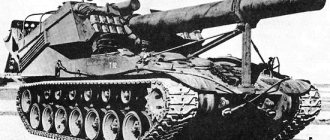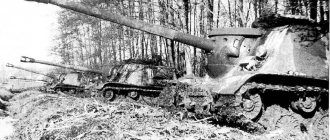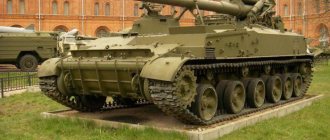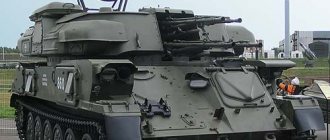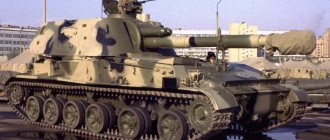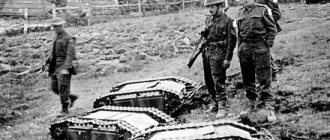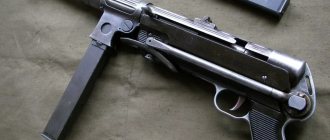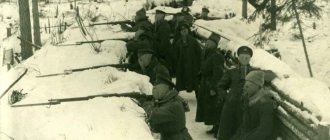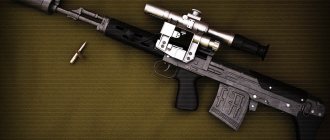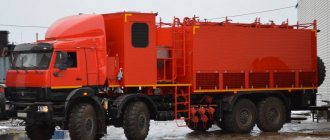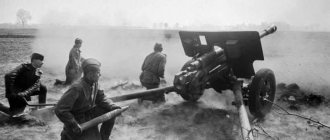The "SAU" request is redirected here; see also other meanings.
Modern Russian self-propelled artillery mount 2S19M2 "Msta-S", Alabino, April 9, 2014.
Self-propelled artillery unit
(
self
, colloquial
Samokhodka
, mouth
Artsamokhod
) is a combat vehicle, which is an artillery gun mounted on a self-propelled (self-propelled) chassis and designed for firing from closed positions and direct fire support for tanks and infantry in battle[1][2].
Self-propelled artillery units should include all armored combat self-propelled vehicles with cannon artillery weapons, except tanks, armored personnel carriers, infantry fighting vehicles and infantry fighting vehicles. The difference from armored personnel carriers and infantry fighting vehicles is that self-propelled guns do not have dismounted troops, but have powerful artillery weapons[3]. The difference from a tank is that a self-propelled gun is a full-fledged artillery piece on a self-propelled chassis, while a tank is armed with a special artillery piece - a tank gun.
The types and purposes of self-propelled guns are very diverse: they can be either armored or unarmored, use a wheeled or tracked chassis. The self-propelled gun can have a full-rotating turret or a fixed wheelhouse gun installation. Some of the self-propelled guns with a turret-mounted gun are very similar to tanks, but they differ from tanks in the armor-weapon balance and combat tactics.
The Russian military theorist and practitioner Dmitry Alekseevich Milyutin already in 1912 predicted the use and appearance in the armed forces of Russia and the world of a car, an armored car, tanks and self-propelled artillery mounts.
“Is there anything impossible, for example, in the fact that cars will not only completely replace carts in convoys, but will even make their way into field artillery? Instead of field guns with horse harnesses, mobile armored batteries will enter the competition on the battlefield, and the land battle will become like a sea battle.”
— D. A. Milyutin, “Senile reflections on the current state of military affairs in Russia” (1912) [4].
The history of self-propelled artillery begins with the history of heavy cannon armored vehicles at the beginning of the 20th century and the development of tanks during the First World War. Moreover, technically, the first French tanks “Saint-Chamon” and “Schneider” are more likely analogues of later assault self-propelled guns than tanks. The middle and second half of the 20th century were a time of rapid development of various self-propelled artillery systems in leading technologically developed countries. The achievements of military science at the beginning of the 21st century - high precision fire, electronic positioning and guidance systems - allowed self-propelled guns, according to experts who note the high role of self-propelled artillery in modern combat, to occupy a significant place among other armored vehicles, which previously belonged entirely to tanks.
According to the Soviet classification of 1933 “On the system of armored and tank weapons of the Red Army”, a self-propelled artillery mount
(on units of a combined arms tank) was
a type of special tank
, and before that it was called
a self-propelled unit
(SU) or
an artillery tank
(AT).
In the Battle Manual of the Armored and Mechanized Troops of the Red Army of 1944, Part 1 (tank, tank platoon, tank company) is called a self-propelled gun
and is intended to be a type of combat vehicle.
During the Second World War, there was an evolutionary division of self-propelled guns into anti-tank self-propelled guns, assault self-propelled guns, self-propelled howitzers and anti-aircraft self-propelled guns.
Anti-tank self-propelled guns had high mobility, high-ballistic guns capable of fighting enemy tanks, light armor or significant armor only in the frontal projection.
Assault self-propelled guns were intended to break through fortified enemy defenses. They were armed with large-caliber guns adapted for the destruction of field fortifications. They had heavy armor allowing them to operate on the front line under enemy fire. Assault self-propelled guns usually had limited mobility. Their tactical role overlapped with that of heavy tanks. If necessary, they were also used in the role of anti-tank weapons, but the low rate of fire, limited ammunition, and often the low muzzle velocity of a large-caliber howitzer projectile significantly reduced their effectiveness as anti-tank weapons.
Self-propelled howitzers are designed for firing from closed positions. They usually have medium mobility and light armor or an open gun mount.
In combat use, the roles of these vehicles overlapped, but the use of self-propelled guns in unsuitable tactical conditions led to a decrease in efficiency and unjustified losses.
In the post-war period, due to the improvement of main tanks, self-propelled artillery guns largely lost their role as an anti-tank weapon and a tool for breaking through enemy defenses. Post-war self-propelled guns are almost exclusively self-propelled howitzers
and anti-aircraft self-propelled guns.
Content
- 1 Differences between self-propelled guns and tanks
- 2 The difference between self-propelled guns and towed artillery
- 3 Russian (Soviet) classification of self-propelled artillery mounts 3.1 By type of gun
- 3.2 By combat weight
- 3.3 By gun caliber
- 3.4 By layout
- 3.5 On armor protection
- 3.6 By purpose
- 7.1 Early development (1914–1939)
Differences between self-propelled guns and tanks[ | ]
Soviet heavy tank destroyer ISU-152 from the Great Patriotic War.
Self-propelled guns differ from tanks in the principles of combat use and the nature of the tasks they solve. First of all, this concerns the balance of firepower, security and mobility, the harmonious combination of which determines, in particular, the essence of a tank or any other combat vehicle.
German heavy anti-tank self-propelled gun "Ferdinand" (Elefant) during the Great Patriotic War
Self-propelled guns are a type of artillery that has high mobility and maneuverability and sufficient security, which allows it to provide continuous fire support for moving troops. Self-propelled guns, as a rule, are not armed with machine guns. Tanks are capable of operating both with infantry and independently. Tanks are also armed with machine guns. The main task of the self-propelled gun is to conduct artillery fire in combination with positional maneuver.
The strike armament of the self-propelled gun is more powerful than that of a tank, but the self-propelled gun is protected worse than a tank of the same mass[5]. The self-propelled gun armor is intended, first of all, to protect enemy airborne and reconnaissance units from small arms, as well as from fragments of fragmentation and high-explosive fragmentation shells, which determines the lack of dynamic and active protection. At the same time, the weapon power of artillery installations is significantly greater than that of tanks. This determines the greater length and weight of the barrel, more advanced navigation and sighting equipment, the presence of ballistic computers (software applications in the combat computers of modern self-propelled guns) and other auxiliary means that increase the efficiency of shooting. Particular attention should be paid to the self-propelled gun, which is a standard artillery gun, with all the resulting advantages over a tank gun (in particular in ballistics and the ability to fire from closed positions), while a tank gun (including due to its ballistics) intended only for direct fire (in modern tanks it is provided with electronic devices). Also, a modern tank gun is smoothbore, which gives it the ability to fire both artillery and rocket shells, but deprives it of some of the advantages of a rifled gun.
StuG IV in game
Research and leveling
This vehicle is a vehicle and does not require upgrading additional modules; it has “Elite” status, brings more experience for each battle, and also has a number of other features.
Combat effectiveness
Equipped with a 75mm gun, the StuG IV makes an excellent ambush sniper thanks to its accuracy, high armor-piercing power and stealth. Poor visibility makes playing with this tactic somewhat difficult, but installing a stereo tube partially compensates for this disadvantage.
With all this, it is important to remember: going into close combat is extremely risky - despite the nominally good frontal armor, it is 80 mm only on a few small parts of the forehead with small angles of inclination, so the armor almost does not work against level 5-6 tanks, and the safety margin enough for literally 2-4 shots from classmates. You can fight in close combat only in a group of heavy or medium tanks, behind which you can always take cover
It is highly not recommended to “shine” in front of Soviet TTs of levels 5-6 (KV-85, KV-2), since they destroy the StuG IV with one shot. Therefore, in the event of close clashes with the enemy, it is necessary to attack those tanks that are engaged in battle and distracted by the allies, as well as use shelters on the ground and in the city in order to avoid return fire.
Among the disadvantages of self-propelled guns, one can note the low reverse speed. Often the Stug simply does not have time to return to cover after being shot and is destroyed. In this regard, it is necessary to correctly calculate time and your own capabilities. For example, in a difficult situation, you can often catch your opponent off guard by rushing at him instead of slowly backing away. Slow tanks, such as the KV-1, are often unprepared for such a turn of events; they are easy to spin. Such maneuvers close to the enemy are risky, but in some cases they can gain time or even destroy the enemy.
Advantages:
- accurate and fast-firing gun with fast aiming;
- low silhouette, excellent camouflage;
- large ammunition load;
- preferential level of battles.
Flaws:
- mediocre booking;
- short viewing range;
- low reverse speed;
- Frequent engine breakdowns due to head-on hits.
Crew
- Combat Brotherhood
will increase the characteristics of the tank. - Camouflage
will increase the machine's stealth. - The combination of Eagle Eye
+
Radio Interception
will increase your visibility by 5%. - The combination of Smooth turret rotation
+
Smooth movement
will allow you to waste less time on alignment when moving and turning the turret. - The sixth sense
will help determine whether a tank is detected or not. - The sniper
will increase the destructive power of the gun. - The off-road king
will increase mobility on soft soils. - Desperate
will increase DPM in heated battles.
Equipment, equipment and ammunition
BB36
BP20
OF5
Equipment
- The rammer
will speed up reloading slightly. - A stereo tube
will give a decent bonus to visibility in a standing position. - The camouflage network
will increase the stealth of the vehicle.
Equipment
Standard equipment - Repair kit
,
First aid kit
,
Fire extinguisher
.
Ammunition
The main shells are armor-piercing. Sub-caliber ones should be loaded for encounters with armored opponents. High-explosive fragmentation shells are useful for knocking down a captured base or finishing off an enemy with a small margin of safety.
StuG IV rating
- Warrior
- for excellent weapon characteristics and high mobility. - Defender
- for high driving performance, allowing you to return to base in time and knock down a tackle. - Invader
- for low visibility, allowing you to successfully reach the enemy base. - Support
- for the low one-time damage of a 75 mm gun. - Armor-piercer
- for the high armor penetration of the 75 mm gun. - Invulnerable
- for the ability to conduct sniper combat at long range.
History of changes
Main article
:
Changelog StuG IV
Changelog
Update 0.9.4
Supertest participants were given a German Tier V tank destroyer StuG IV.
Update 0.9.5
The German Tier V tank destroyer StuG IV was introduced as a reward for the first operation of personal combat missions.
The difference between self-propelled guns and towed artillery[ | ]
| This section is missing references to information sources. Information must be verifiable, otherwise it may be questioned and deleted. You may edit this article to include links to authoritative sources. This mark was set on June 18, 2020 . |
Self-propelled artillery mounts have both advantages and disadvantages in comparison with towed guns.
The advantages include:
- Higher mobility compared to towed guns, speed of deployment and collapse of the firing position.
- In the case of a closed conning tower, tower or armored fence, the crew is more protected from enemy fire.
- The presence of a power plant makes it possible to mechanize the operations of pointing, loading the gun and manipulating ammunition.
- The presence of a self-propelled chassis allows the installation of self-excavation equipment.
- Automation of loading and guidance makes it possible to significantly increase the rate of fire of a gun and implement a mode of simultaneous destruction with several projectiles[en], bringing the tactical capabilities of cannon artillery closer to multiple launch rocket systems.
- If there is a closed wheelhouse or cabin, it is possible to protect the crew from the damaging factors of weapons of mass destruction and adverse weather conditions.
- Self-propelled artillery units are less dependent on auxiliary vehicles.
- On anti-aircraft self-propelled artillery installations, the presence of a self-propelled chassis allows the installation of radar stations for target detection and guidance.
- The ability to use artillery systems that are too bulky for a towed chassis.
Disadvantages in comparison with towed artillery are:
- High cost of production and operation.
- Limited strategic and operational mobility.
- Dependence on the availability of fuels and lubricants and repair facilities.
- If the gun is installed in a closed wheelhouse or turret, there will be cramped working conditions for the crew and gas pollution in the fighting compartment.
- A more limited choice of firing positions is associated with limited maneuverability and the difficulty of camouflaging self-propelled guns.
High autonomy, the ability to quickly change positions, and the presence of armor ensure high survivability of self-propelled guns on the battlefield, their greater resistance to counter-battery fire, which partially compensates for their high cost.
The use of towed artillery is greatly complicated in the context of the use of weapons of mass destruction, which led to the massive development of self-propelled guns with closed fighting compartments in the post-war period.
At the same time, self-propelled guns (especially heavy assault guns) are much larger in size and weight compared to their towed counterparts. This significantly complicates their transportation by rail and air transport, overcoming water obstacles, and requires a repair base and significant reserves of fuel and lubricants.
The ability of self-propelled guns to move as part of mechanized units allows one to significantly increase their firepower in offensive operations, and in defense to quickly respond to enemy movements and breakthroughs.
Russian (Soviet) classification of self-propelled artillery units[ | ]
SAU 2S35 "Coalition-SV".
By type of weapon[ | ]
Based on the type of gun, self-propelled guns are divided into the following classes[1]:
- self-propelled guns
- self-propelled howitzers
- self-propelled howitzer guns
By combat weight[ | ]
Based on their combat weight, self-propelled guns are divided into the following classes[1]:
- light (up to 20 tons)
- medium (up to 40 tons)
- heavy (over 40 tons)
By gun caliber[ | ]
French self-propelled gun "Caesar" at the Quartier Général-Sabatier military base in Lyon.
June 13, 2013 Based on the caliber of the self-propelled guns, self-propelled guns are also divided into:
- light (up to 50 mm)
- medium (no more than 122 mm)
- heavy (152 mm or more)
Since World War II, almost all lightly armed self-propelled guns are anti-aircraft.
By layout[ | ]
Based on the location of the fighting compartment, self-propelled guns are divided into the following types[1]:
- with a front-mounted fighting compartment
- with a mid-mounted fighting compartment
- with rear-mounted fighting compartment
For armor protection[ | ]
According to the armor protection of the fighting compartment, self-propelled guns are divided into the following types[1]:
- fully armored (closed type)
- partially armored, semi-closed type - these self-propelled guns had no roof in their conning towers
- open type - these self-propelled guns had no conning towers, the guns were mounted directly on the platform, and the crew was protected only by the gun’s armor shield.
By purpose[ | ]
In the post-war years, the USSR conducted a study and generalization of combat experience, on the basis of which a classification of self-propelled artillery guns was made. Depending on their purpose, they were divided into the following groups[6]:
- anti-tank self-propelled guns (tank destroyers) - were intended to fight enemy tanks and their anti-tank weapons when accompanied by friendly troops.
- self-propelled assault guns (pillbox destroyers) - used to destroy durable long-term structures on the front line of enemy defenses with direct fire (for example, Soviet SU-152/ISU-152 were quite often used as anti-pillbox guns)
- escort self-propelled artillery installations (self-propelled howitzers) - accompanied with fire infantry and motorized units and formations, performing the tasks of destroying enemy personnel and firepower, as well as combating medium and light tanks. (The SU-122 and SU-152/ISU-152 were designed precisely for such combat use. But they were also effective against heavy tanks. Thus, the SU-152/ISU-152 destroyed Tiger tanks with high-explosive shells.)
- anti-aircraft self-propelled guns - served to cover troops from air attacks on the march and during the offensive.
- special self-propelled launchers - these included mortar and rocket launchers, as well as field missile launchers on a self-propelled base.
Prerequisites
In 1935, Erich von Manstein, in a letter to General Beck, described the idea of “assault artillery” vehicles, the main task of which should be direct support for attacking infantry units. After detailed requests were processed, on June 15, 1936, Daimler-Benz received an order to design armored infantry support vehicles armed with a 75 mm cannon, with a horizontal guidance angle of at least 25°. The vehicle had to be fully armored, thereby protecting the crew from enemy fire, and the total height should not exceed the height of the average soldier. To develop the new self-propelled gun, Daimler-Benz decided to use the chassis of the new PzKpfw III medium tank.
The first five prototypes were produced in 1937 on the PzKpfw III Ausf chassis. B. They were armed with a short-barreled (L/24 - 24 caliber barrel length) 75 mm Sturmgeschütz 7.5 cm Kanone
(Stu.G. 7.5 cm K.) with a low initial projectile speed.
After a clash in the USSR with T-34 tanks, it was decided to equip the StuG III with a long-barreled gun with a more powerful charge in the cartridge case, capable of penetrating the armor of Soviet tanks. Since the spring of 1942, 75-mm Stu.K
40 L/43 , and in the fall of this year even longer-barreled versions of this gun -
L/48
.
Later StuG III models were also equipped with a 7.92 mm MG-34 machine gun mounted in front of the commander's hatch (as there was no other way to mount the machine gun).
All vehicles from the Sturmgeshutz series were cheaper to produce than tanks on the same chassis. The StuG III cost 82.5 thousand marks, while the PzKpfw III cost over 103 thousand marks (the towed version of the same 75 mm gun used in the Sturmgeschütz III cost 12 thousand marks).
In total, over 10,500 copies were produced in various modifications before the end of the war.
Wehrmacht classification[ | ]
The Wehrmacht used a rather complex classification system for armored vehicles. The army classification included the following types of armored vehicles that can be classified as self-propelled guns[7]:
- Flakpanzer (Flak Pz.) - anti-aircraft tank (ZSU)
- Jagdpanzer (Jagd Pz.) - tank destroyer (anti-tank self-propelled gun based on the main tank)
- Panzerjäger (Pz.Jäg.) - anti-tank self-propelled guns based on outdated tanks, armored personnel carriers, etc.
- Sturmgeschütz (StuG) - assault gun
- Sturmhaubitze (StuH) - assault howitzer
- Selbstfahrlafette (Sfl.) - self-propelled field artillery system
Tactics for using self-propelled guns[ | ]
SU-14 with a 203-mm howitzer B-4
According to the modern concept of combat, the main areas of application of self-propelled artillery mounts are the tasks of mobile support with artillery fire from closed firing positions of units and subunits of other branches of the military and artillery offensive. Thanks to their high mobility, self-propelled guns are capable of accompanying tanks during deep breakthroughs of enemy defenses, dramatically increasing the combat capabilities of tank and motorized infantry units that have broken through. The same mobility makes it possible to suddenly launch artillery strikes against the enemy using self-propelled artillery forces independently without the assistance of other types of troops. To do this, all the data for shooting are calculated in advance using the method of complete preparation. Self-propelled guns move into a firing position, fire at the enemy without sighting and sometimes even without adjustment, then leave the firing position. Thus, when the enemy determines the location of the firing position and takes action, it will be too late - the self-propelled guns are no longer there.
In the event of a breakthrough by enemy tanks and motorized infantry, self-propelled guns can also be used as an effective anti-tank weapon. For this purpose, their ammunition includes special types of projectiles, such as the Krasnopol guided winged 152.4 mm artillery projectile. Recently, self-propelled guns have mastered a new use for themselves in the role of a “super-heavy anti-sniper rifle”, capable of destroying enemy snipers in conditions that are very difficult to hit with other fire weapons (for example, destroying snipers’ shelters).
Armed with tactical nuclear shells, single self-propelled guns are capable of destroying large objects, such as airfields, railway stations, forts (fortified settlements) and concentrations of enemy troops. At the same time, their shells are practically impossible to intercept, unlike tactical missiles with nuclear warheads or aircraft with nuclear bombs. However, the radius of possible targets to be hit and the power of a nuclear explosion of artillery ammunition are significantly less than that of aerial bombs or tactical missiles.
SPG layout[ | ]
SU-5
The most common self-propelled howitzers at present are, as a rule, built either on the basis of light multi-purpose lightly armored tracked vehicles, or on the basis of tank chassis. However, in both cases the layout of components and assemblies is almost the same. Unlike a tank, the gun's turret is located not in the middle, but in the rear of the vehicle's armored hull for more convenient supply of ammunition from the ground. Accordingly, the engine-transmission group is located in the middle and/or front part of the armored hull. Due to the location of the transmission in the nose of the vehicle, the front wheels are driven (in modern tanks, as a rule, it is the other way around - the drive wheels are located at the rear). The driver's workplace (control compartment) is located next to the gearbox in the center or left side of the car, the engine is located between the control compartment and the fighting compartment.
The fighting compartment contains the gun crew, transportable ammunition, subsystems for the device and gun guidance.
Artillery ZSU (anti-aircraft self-propelled installation) are quite diverse in their layout solutions: they can use both the above-described version of the layout diagram of a self-propelled howitzer, and the placement of components and assemblies according to a tank model. The latter is typical for Soviet artillery ZSU (a striking example of the Shilka ZSU). Sometimes the ZSU is a tank whose standard turret has been replaced with a special one with rapid-firing air defense guns and corresponding guidance systems. In the latter case, it is no longer a ZSU but a full-fledged air defense tank. In some cases, such a tank can also be used as a BMPT. (Many modern ZSUs, such as the Russian Tunguska and Pantsir, are rocket and artillery.)
There are designs on heavy vehicle chassis, for example, the Czech 152-mm self-propelled gun-howitzer vz.77 “Dana” on the chassis of a Tatra-815 car with an 8x8 wheel arrangement.
TTX
general information
- Classification – assault weapon;
- Combat weight - 23.4 tons;
- Layout diagram - transmission compartment in front, engine compartment in the rear, controls and combat compartment in the center;
- Crew – 4 people;
- Years of development: 1937;
- Years of production – 1940-1945;
- Years of operation – 1940-1950;
- A total of 10,500 vehicles were produced.
Booking
- Type of armor – cast and rolled steel;
- Body forehead, top - 25+30 / 85° mm/degree;
- Body side – 30 mm;
- Hull stern, top - 30 / 30° mm/degree;
- Bottom – 19 mm;
- Hull roof - 16/78-87° mm/degree;
- Cutting forehead - 50+30 / 9° mm/degree;
- Gun mask - 50+30 / 5° mm/degree;
- Cabin side - 30 / 0° + 8 / 30° mm/degree;
- Cabin roof - 10/78-90° mm/degree.
Armament
- Gun - Stuk 40 L/48 caliber 75 mm;
- Gun type - rifled;
- Barrel length - 24 caliber;
- Gun ammunition - 54 rounds;
- BH angles - −10...+20° degrees;
- GN angles – 12 degrees;
- Sights - Periscopic sights SfI ZF 1a and RbIF 36;
- Machine gun - MG 34 caliber 7.92 mm.
Mobility
- Engine type - V-shaped 12-cylinder carburetor, liquid-cooled;
- Engine power – 300 horsepower;
- Speed on highways and rough terrain – 38 km/h;
- Cruising range – 155 km;
- Specific power – 12.8 hp/t;
- Suspension type: Individual torsion bar, with hydraulic shock absorbers;
- Climbability – 30 degrees;
- The wall to be overcome is 0.6 m;
- The ditch to be overcome is 2.3 m;
- Fordability - 0.8 m.
Brief history of the development of self-propelled guns[ | ]
Schumann armored carriage. Cannon (57 mm) horse-drawn armored platform of the Bulgarian army during the First World War
Early period of development (1914-1939)[ | ]
German armored car with a 75 mm Krupp gun.
1915 British World War I self-propelled gun Gun Carrier Mark I (60-pounder gun). At the beginning of their development, self-propelled artillery mounts represented a wide conglomerate of various design ideas and their embodiments in metal. On the battlefields of the First World War, artillery pieces were used mounted on the chassis of commercial trucks, farm tractors, and even on tracked chassis, driven by electrical power through wires from an external electric generator (with negligible advances in trench warfare, this was not surprising). However, the development of tanks determined the further course of design searches - the realization came that a tank base was the most optimal for the installation of powerful artillery systems. Guns on unarmored chassis were not forgotten either - at that time they had much greater mobility than slow-moving tanks and could be quickly deployed to the most dangerous areas of combat operations.
In Russia, the project of a super-heavy, heavily armored self-propelled gun to combat enemy fortifications was proposed by V. D. Mendeleev, the son of the famous chemist D. I. Mendeleev. This project, known as the Mendeleev Tank, was very advanced for its time, but was not embodied in metal. During the First World War and the Civil War, F. F. Lender's self-propelled "anti-airplane" 76.2 mm guns based on Russo-Balt trucks were actively used. Some of them even had partially armored cabins.
In the 1920s, self-propelled artillery mounts were actively experimented with in the Soviet Union and Germany. Also, the famous tank designer W. Christie built a number of self-propelled gun prototypes in the USA. However, most of these projects can be classified as surrogate self-propelled guns on automobile or tractor chassis - due to the lack or absence of an industrial base and a sufficient number of tank chassis.
In the next decade, the USSR and Nazi Germany created productive tank production and, as a result, numerous tank forces, and it became possible to use tank chassis to create self-propelled guns. In the USSR, experimental prototypes of the SU-14 heavy self-propelled guns were created based on the T-35 and T-28 heavy tanks. They produced a small series of self-propelled guns for direct infantry support based on the T-26 light tank and the T-27 wedge. In Germany, obsolete light tanks Pz Kpfw I were used for conversion into self-propelled guns. In other countries, self-propelled guns were considered as a surrogate for tanks and were practically not used. (As the Second World War would later show, this was a strategic military-technical mistake of all those who refused to use self-propelled guns.)
World War II (1939-1945)[ | ]
German tank destroyer StuG III Ausf G Sturer Emil.
German heavy 128-mm tank destroyer on the VK3001(H) chassis in the Armored Museum in Kubinka. A full-scale major war required the warring parties to make full use of all available resources. Germany was the first to face this - many obsolete and captured tanks were converted into self-propelled guns, and cheaper and easier-to-manufacture self-propelled artillery units were created on the basis of their own modern vehicles. The outstanding German assault guns StuG III and StuG IV based on the Pz Kpfw III and Pz Kpfw IV, respectively, the self-propelled howitzers Wespe, Hummel, Grille and the tank destroyers Hetzer, Elefant (called Ferdinand until February 27, 1944), and Jagdpanther are widely known " and "Yagdtiger". Starting from the second half of 1944, the production of various self-propelled guns in Germany exceeded the production of tanks.
The Red Army met the war without large-scale self-propelled guns (although some researchers classify the KV-2 heavy tank as an assault gun). However, already in July 1941, the ZIS-30 self-propelled gun was built, and by the end of 1942, the first serial SU-122 assault guns entered service. The confrontation with heavy German armored vehicles and fortifications brought to life such examples of Soviet self-propelled guns as the ISU-152 and SU-100. All Soviet self-propelled guns of that time (unlike the highly specialized German ones) were universal combat vehicles. The only class of self-propelled guns in which there was no worthy Soviet representative [ source not specified 3722 days
], turned out to be self-propelled howitzers (the SU-122 and SU/ISU-152 were used as them, but infrequently and with great inconvenience - since they were more like assault guns). The modernized SU-100 and ISU-152 were in service with the Soviet Army for another two decades after the end of World War II. The Uralmash plant in Yekaterinburg produced the last SU-100 in 1946; it did not see combat - the workers installed the self-propelled gun on a pedestal as a monument[8].
See also: s:Category:Documents on the combat use of self-propelled artillery and s:Category:Documents on the fight against enemy self-propelled artillery
Anglo-American designers focused more on the development of a class of self-propelled howitzers (M7 Priest, M12, Bishop, Sexton) and somewhat less on the development of anti-tank self-propelled guns (M10 Wolverine, M18 Hellcat, M36 Jackson, Archer).
Modern period (1945 - present)[ | ]
Complex 2S1 “Gvozdika” (122-mm self-propelled howitzer).
The development of the main battle tank concept led to the disappearance of assault guns as a class of combat vehicles. Numerous anti-tank missile systems and combat helicopters have made tank destroyer self-propelled guns obsolete. As a result, self-propelled howitzers and self-propelled anti-aircraft guns (ZSU) were further developed. Recently, many subclasses of self-propelled guns have evolved from artillery and missile to combined - missile and artillery. In the USSR, the rapid development of missile technology even had a negative impact on the development of cannon artillery, but by the early 1970s, self-propelled guns veterans of the Great Patriotic War were replaced by modern artillery systems 122-mm 2S1 “Gvozdika”, 152.4-mm 2S3 “Akatsiya” and 2S5 "Gyacinth", 203-mm 2S7 "Pion", 240-mm self-propelled mortar 2S4 "Tulip", also known as the "Flower Series". Further development led to the creation of the most advanced Soviet and Russian self-propelled guns: the airborne 120 mm 2S9 “Nona”, 152.4 mm 2S19 “Msta-S” and 152.4 mm 2S35 “Coalition-SV”. The line of development of artillery ZSUs was continued by the ZSU-23-4 “Shilka” complexes. The 2K22 Tunguska, which replaced the Shilka, is already a missile and artillery ZSU.
Despite the enormous development of modern high-precision missile weapons, self-propelled howitzers have not lost their importance. The main reasons for the development of self-propelled artillery systems are:
- artillery shells are not subject to interference and are less dependent on meteorological conditions;
- the impossibility of intercepting artillery shells by air defense systems;
- the cost of a projectile is significantly less than missiles;
Thanks to modern radar and space reconnaissance and navigation equipment, the accuracy of cannon artillery fire has been increased. Automated control systems are capable of simultaneously aiming dozens of guns at a target, synchronizing their shots. Modern self-propelled guns are capable of operating in “heavy fire” mode, in which several shells fired along different trajectories from one gun simultaneously hit the target[9]
Today, many countries around the world are armed with self-propelled artillery systems, both tracked and wheeled self-propelled artillery systems.
Some modern self-propelled guns[ | ]
- 2S25 or “Sprut-SD” (Russia) - designed to combat tanks and other armored vehicles and enemy personnel as part of units of the airborne troops, marines and special forces;
- 2S31 or “Vena” (Russia) - designed to suppress manpower, artillery and mortar batteries, rocket launchers, armored targets, fire weapons and control posts;
- 2S34 "Khosta" (Russia) - is a deep modernization of the 2S1 "Gvozdika" with the introduction of a number of components 2S31 "Venya", 2S23 "Nona-SVK", as well as "Object 118" (GMZ) and is designed to suppress manpower, artillery and mortars batteries, missile launchers, armored targets, fire weapons and control points at a distance of up to 14 km;
- M109A6 “Paladin” (USA) is a self-propelled howitzer in production since 1994, a modernized and improved model of the M109 self-propelled gun. It is in service with a dozen countries around the world;
- XM1203 NLOS-C (USA) - the first project developed as part of the American Future Combat Systems (FCS) program;
- PzH 2000 (Germany) - self-propelled guns developed by Krauss-Maffei Wegmann, is in service with a number of NATO countries;
- CAESAR (France) - 155-mm self-propelled guns, developed and produced by Nexter in service with France, Denmark, Indonesia, Saudi Arabia and Thailand;
- ATMOS 2000 (Israel) - 155-mm self-propelled guns are designed to destroy manpower, artillery batteries, bunkers, as well as to provide passages in minefields and field obstacles;
- NORA B-52 (Serbia) - 155-mm self-propelled howitzer, created by Serbian military engineers in 2006 as the latest mobile and high-speed self-propelled guns;
- SH1 (PRC) - a highly mobile self-propelled artillery unit of the self-propelled howitzer class, developed by the Chinese corporation "Norinco" for export;
- FH77 BW L52 “Archer” (Sweden) - 155-mm multi-purpose self-propelled artillery howitzer, a distinctive feature is the absence of the need for additional crew numbers to load it. Developed by BAE Systems Bofors.
Ersatz self-propelled guns[ | ]
Mortar 2B9 Vasilek mounted on an MT-LB tractor.
In conditions of a shortage of direct fire support, participants in armed conflicts used available resources to create ersatz self-propelled guns.
Typically, such vehicles are created through the makeshift installation of towed guns and mortars on the chassis of trucks or armored vehicles.
Typical examples are the installation of ZU-23-2, S-60 anti-aircraft guns, Vasilek mortars on MT-LB chassis and trucks.
In low-intensity conflicts and (counter)guerrilla operations, such vehicles have proven themselves to be a valuable means of strengthening combat groups.
Conclusions.
So let's summarize all of the above. Having reached Ferdinand, we received an excellent, balanced combat unit, which in some cases, in the right hands, is capable of dragging out the battle and changing its course in favor of the allies. Having fairly good forehead armor, a powerful weapon with excellent accuracy and penetration, we are able to hit the most armored targets. Moreover, do this from medium distances with minimal risk to yourself. Enjoy all the charms of this tank destroyer, you will never want to sell it. Correct play and deliberate actions bring a lot of pleasure and positivity. Happy fighting!
Notes[ | ]
- ↑ 12345
Self-propelled artillery installation // Soviet military encyclopedia: [in 8 volumes] / chairman. Ch. ed. commission of A. A. Grechko [vol. 1, 8], N.V. Ogarkov [vol. 2-7]. - M.: Military publishing house of the Ministry of Defense of the USSR, 1976-1980. - Self-propelled artillery mount // “Military Encyclopedic Dictionary”.
- Section 2. “Self-propelled artillery units (self-propelled guns).” // “Tanks and tank troops.” / A. Kh. Babajanyan. - M.: “Military Publishing House of the USSR Ministry of Defense”, 1970.
- Tsamutali A. N.
“D. A. Milyutin and his “Senile Reflections on the Current State of Military Affairs in Russia.” // “Power, society and reforms in Russia in the 19th – early 20th centuries: research, historiography, sources.” / A. N. Tsamutali. - St. Petersburg: "Nestor-History", 2009. - 396 p. Archived copy from March 16, 2020 on the Wayback Machine - Latukhin A. N.
Self-propelled artillery // Modern artillery / M.. - Military Publishing House of the USSR Ministry of Defense, 1970. - P. 167-186. — 320 s. - Karpenko A.V.
Development of self-propelled artillery installations during the Great Patriotic War and the first post-war years // Domestic self-propelled artillery and anti-aircraft installations. - Nevsky Bastion, 1996. - T. 1. - 88 p. — ISBN 5-85875-050-8. Archived copy from April 2, 2020 on the Wayback Machine - Shmelev I.P.
Armored vehicles of Germany 1934-1945: Illustrated reference book. - M.: AST, 2003. - 271 p. - Anna Osipova.
The last self-propelled gun of Uralmash will be removed from its pedestal in 30 years - to read a message from 1946
(unspecified)
. www.oblgazeta.ru. Retrieved September 8, 2020. - Sytin L.E. The most modern weapons and military equipment. - M.: AST, 2020. - 656 p. — ISBN 978-5-17-090382-5
Notes
- (unavailable link). Achtung Panzer!
. Retrieved February 12, 2014.
- .
- Svirin M.N.
Stalin’s self-propelled guns. History of the Soviet self-propelled guns 1919-1945. - M.: Yauza, Eksmo, 2008. - P. 118. - 384 p. — (War and us. Soviet tanks). — 10,000 copies. — ISBN 978-5-699-20527-1, BBK 68.513 C24. - Svirin M.N.
Stalin’s self-propelled guns. History of the Soviet self-propelled guns 1919-1945. - M.: Yauza, Eksmo, 2008. - P. 142. - 384 p. — (War and us. Soviet tanks). — 10,000 copies. — ISBN 978-5-699-20527-1, BBK 68.513 C24. - Svirin M.N.
Stalin’s self-propelled guns. History of the Soviet self-propelled guns 1919-1945. - M.: Yauza, Eksmo, 2008. - P. 188, 189. - 384 p. — (War and us. Soviet tanks). — 10,000 copies. — ISBN 978-5-699-20527-1, BBK 68.513 C24.
